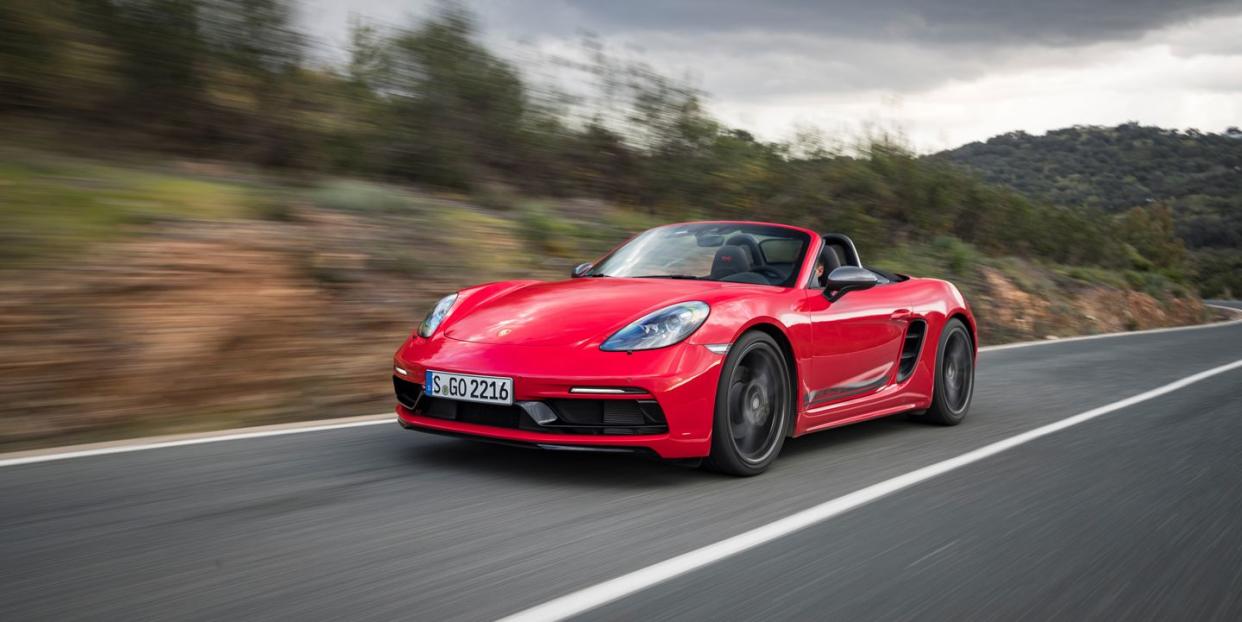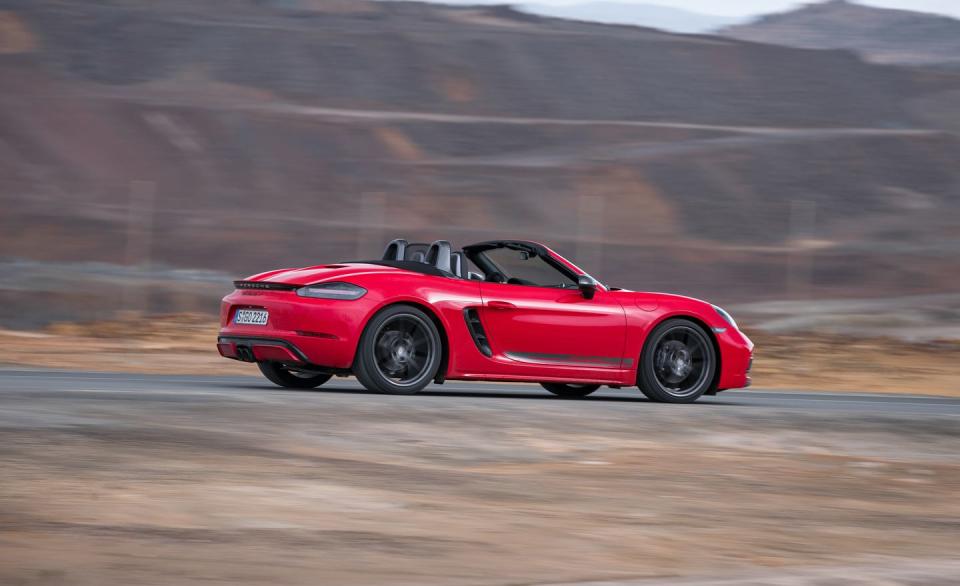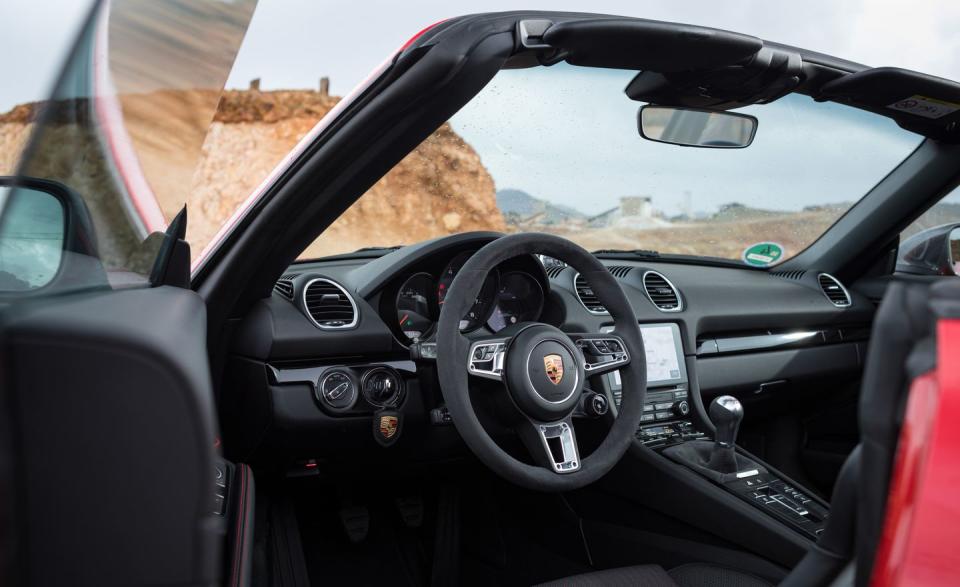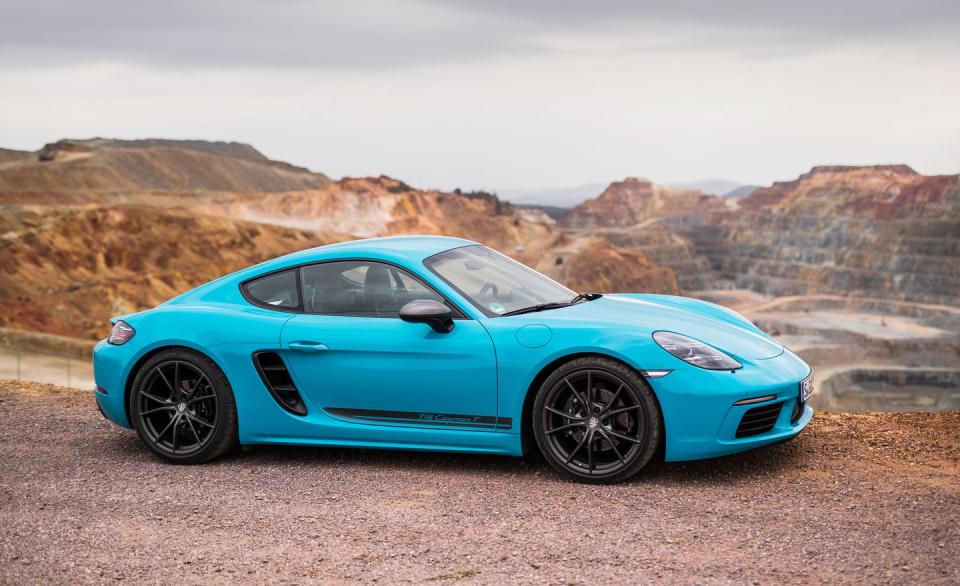The Porsche 718 T Is Pure Driving Enjoyment

Whenever Porsche looks to expand its lineup with new model variations, it often needs only to look at its own vehicle history. For example, there are the T models that served at the lower end of the 911 lineup in the late 1960s, which influenced the recent return of the 911 T to the 991.2 lineup. Fittingly, Porsche is extending the T's driver-focused ethos with the launch of the new 718 T, both in Cayman coupe and Boxster softtop guises.
Just don't confuse the T-badged cars for entry-level models. As with the 911 T, Porsche will charge a premium for their blend of dynamic options, simpler interior features, and distinct styling touches. Based on the standard, non-S 718, both T versions are powered by a turbocharged 2.0-liter flat-four good for 300 horsepower and 280 lb-ft of torque. The engine's redline is a pleasantly high 7400 rpm, and U.S. versions will go and sound even better than the European models we sampled, thanks to the absence of the exhaust particulate filter required to meet European emissions regulations.

A Proven Combination
Porsche has received some flak for swapping the Boxster and Cayman's previous-and sonorous-naturally aspirated flat-sixes for the turbo fours. But we're growing accustomed to the new engine's character, and it's hard to argue with its swell of low-end torque. The engine also syncs with the heritage of the car, with its throb at idle and aggressive, slightly raspy sound reminding us of Porsche's 914 2.0 of the 1970s, arguably the true predecessor of the 718 models. The 2.0-liter's output is just right for thoroughly enjoying the 718 and slightly reduces the constant threat of felonious speed.
Porsche claims that the T's zero-to-60-mph dash will take 4.9 seconds with the standard six-speed manual and 4.5 with the optional PDK seven-speed dual-clutch automatic transmission. From our previous tests of standard 718 models, however, we predict that 3.9- and 4.4-second sprints are more realistic. Top speed is claimed by Porsche to be a lofty 171 mph regardless of transmission or body style.

We appreciate the option to choose between the manual and the automatic, the latter a $3210 option on the current 718 models, as there are valid arguments for both. The automatic shifts seamlessly, and at highway velocities its seventh gear lowers the engine revs considerably. For manual intervention, in addition to the paddles on the steering wheel, you can also use the central gear selector with its proper pull-to-upshift, push-to-downshift actuation-a feature that has been lost on the latest 2020 Porsche 911. The setup of the manual gearbox is exquisite and is our preferred choice, but the experience is severely marred by a rev-matching function that, while excellently calibrated, cannot be deactivated once you have selected the Sport or Sport+ driving modes. Memo to Porsche: Not all of us need such electronic crutches.
The Special Sauce
The 718 handles superbly and its limits are pushed further with the 718 T, thanks to its 20-inch wheels and a range of standard dynamic equipment: a limited-slip differential and brake-based torque vectoring, the Sport Chrono package (a clock/stopwatch on the dash, a driving-mode switch on the steering wheel), launch control, and a Sport mode for the stability control), dynamic engine and gearbox mounts, and Porsche's PASM Sport suspension with adaptive dampers that lowers the chassis by 0.8 inch-0.4 inch lower than the 718's regular PASM setup. The electrically assisted power steering is perfectly weighted and incredibly precise, which combines with the chassis to help the 718 T reach massive cornering speeds with great control.

Yet the 718 T models are just comfortable enough to travel for hundreds of miles without tiring, not least thanks to the wonderfully firm and supportive sport seats with minimalist two-way power adjustment. The interior also gains fabric loops instead of metal door handles, as well as a shorter manual shift lever and a range of "718" and "Boxster T" or "Cayman T" emblems. In Europe, you can even delete the entire infotainment system, but this purist option won't make it to the United States.
Outside, the T variants can be recognized by dark painted wheels and unique decals on the lower body sides, the better to underscore their classic look and remind onlookers of the cars' special status. Porsche has yet to officially confirm the 718 T's arrival in the U.S., but we expect the cars to be available early next year as 2020 models and to carry roughly a $10K upcharge over the standard Boxster and Cayman, which for 2019 start at $60,250 and $58,150, respectively. As with the 718's GTS models, the premium for the T configuration represents a slight value play over the cost of similarly equipped non-T versions. Porsche's extensive option and customization menus will, of course, be available to further enhance the uniqueness of either version.
('You Might Also Like',)

